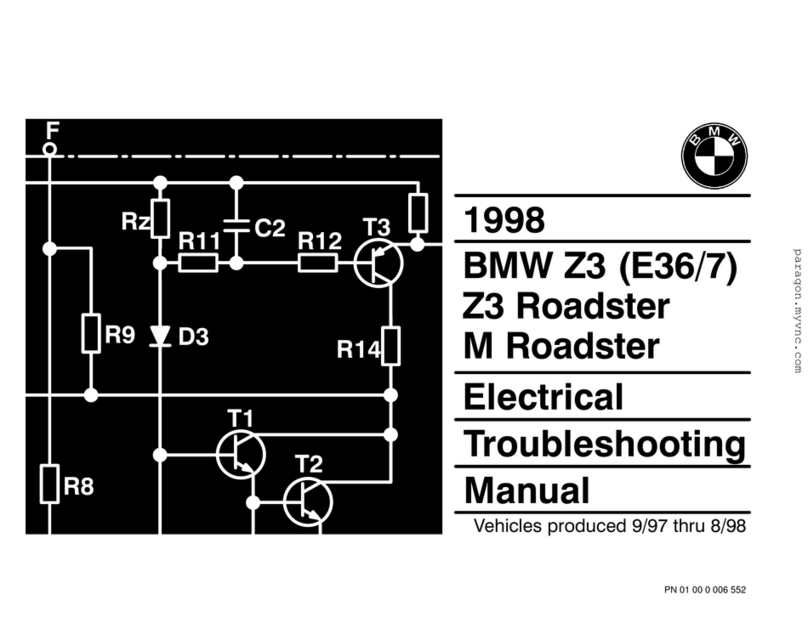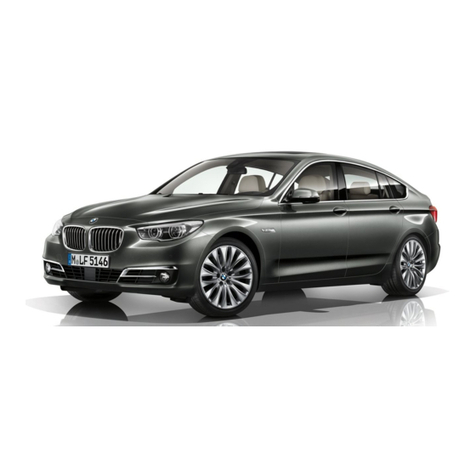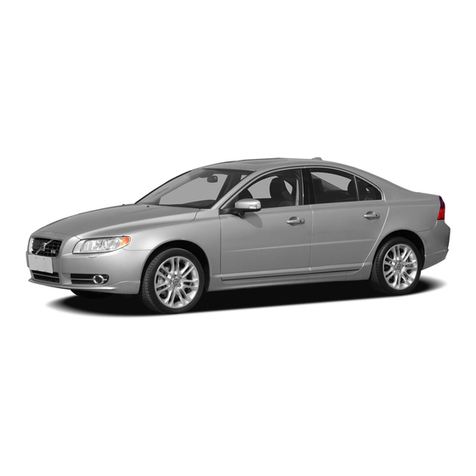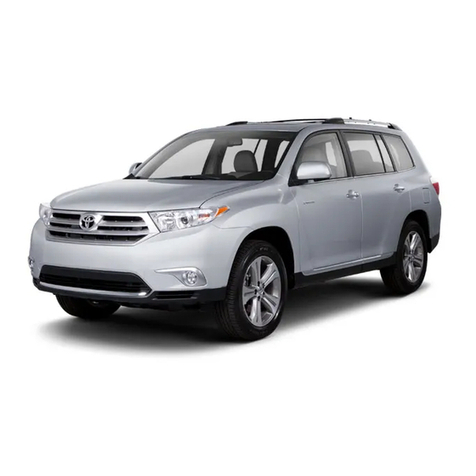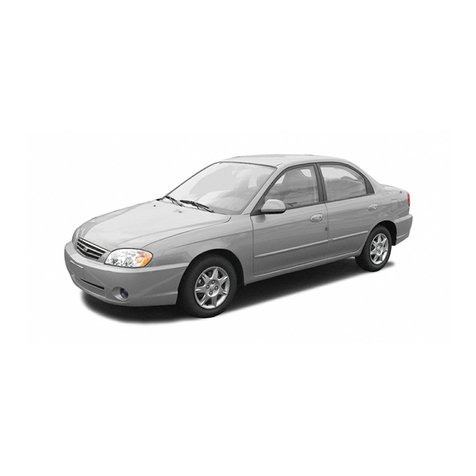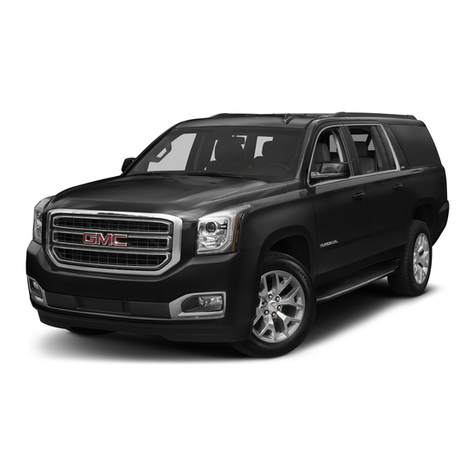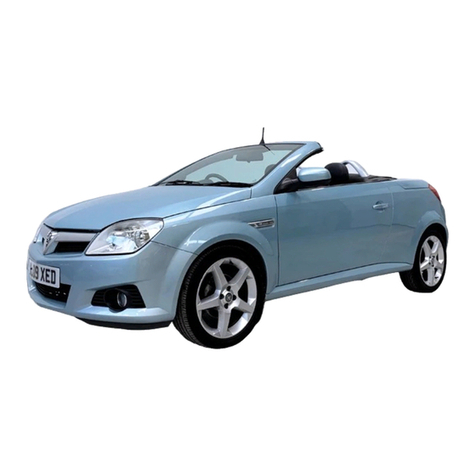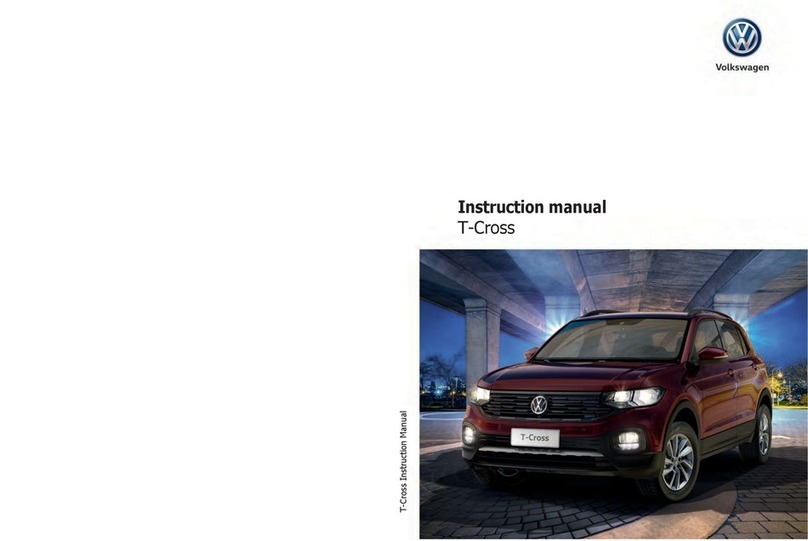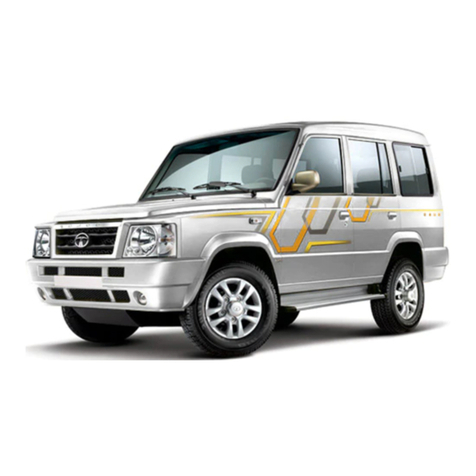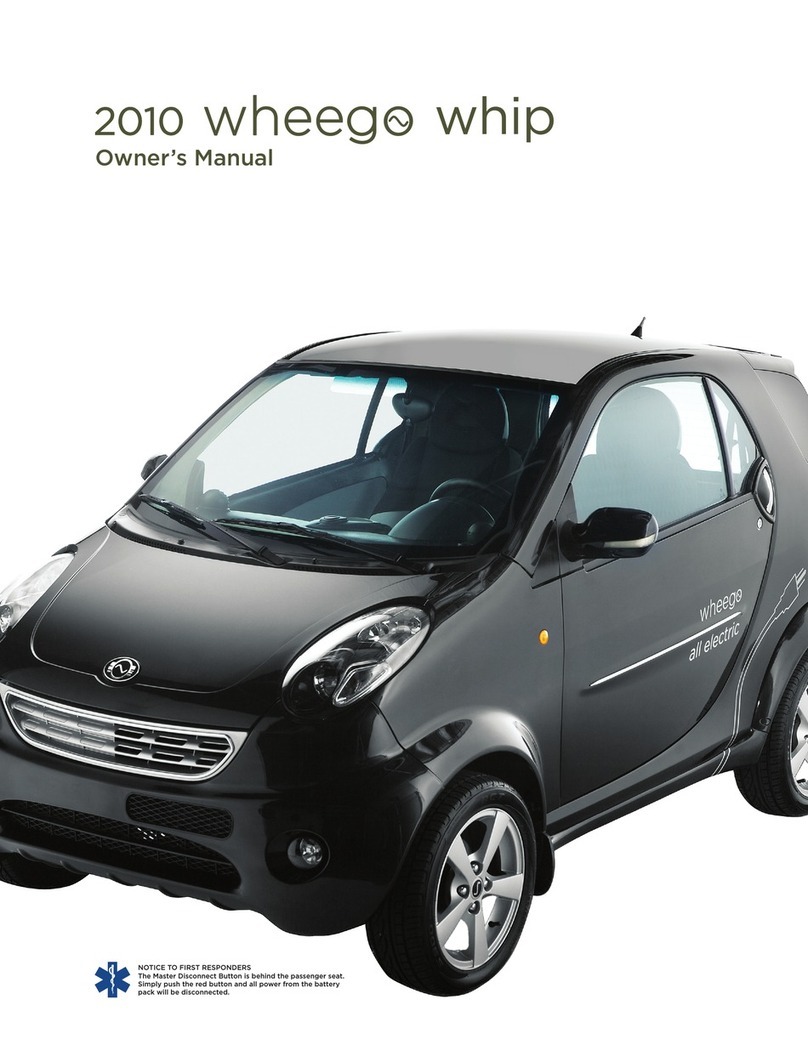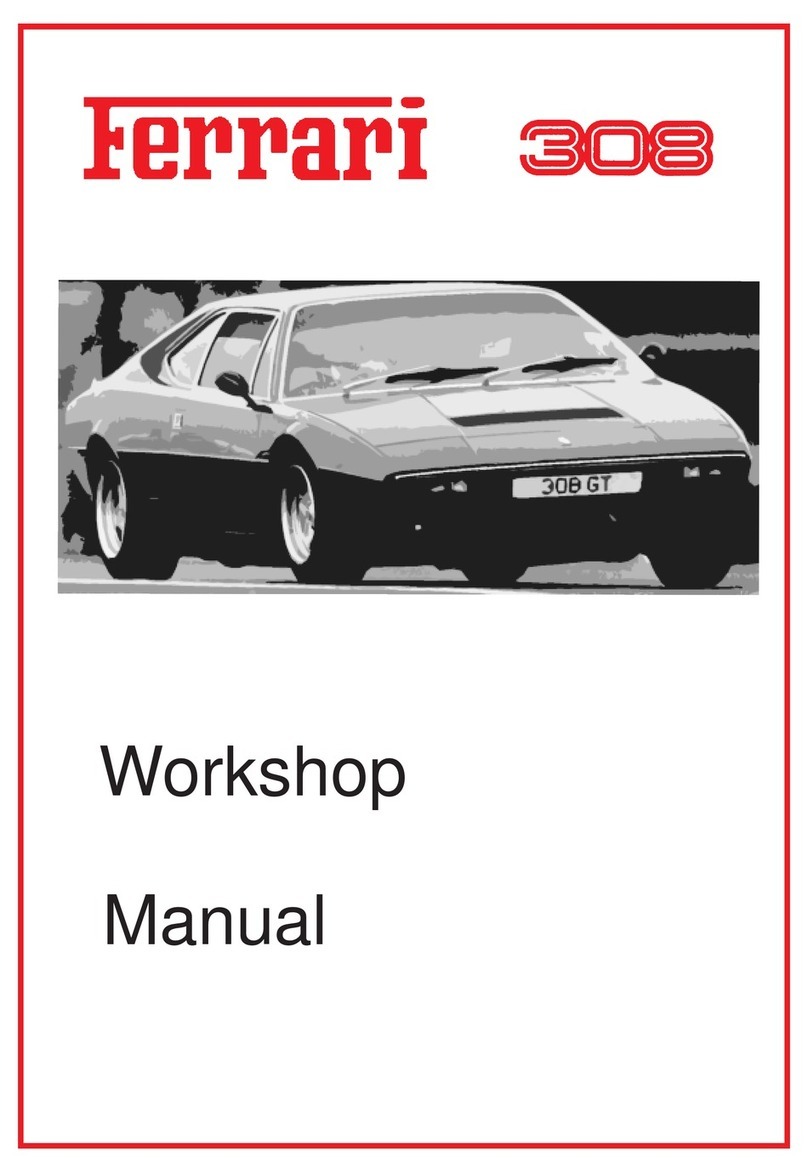BMW E61 Sports Wagon 530xiT User manual

Initial Print Date: 03/05
Table of Contents
Subject Page
Introduction . . . . . . . . . . . . . . . . . . . . . . . . . . . . . . . . . . . . . . . . . . . . . . . . . .4
Dimensions . . . . . . . . . . . . . . . . . . . . . . . . . . . . . . . . . . . . . . . . . . . . . . . . . . . .5
Suspension . . . . . . . . . . . . . . . . . . . . . . . . . . . . . . . . . . . . . . . . . . . . . . . . . . .6
Air Suspension . . . . . . . . . . . . . . . . . . . . . . . . . . . . . . . . . . . . . . . . . . . . . . . . .6
xDrive with DSC8+ . . . . . . . . . . . . . . . . . . . . . . . . . . . . . . . . . . . . . . . . . . . .8
xDrive . . . . . . . . . . . . . . . . . . . . . . . . . . . . . . . . . . . . . . . . . . . . . . . . . . . . . . . . .9
DXC8+ . . . . . . . . . . . . . . . . . . . . . . . . . . . . . . . . . . . . . . . . . . . . . . . . . . . . . . . .9
System Circuit Diagram . . . . . . . . . . . . . . . . . . . . . . . . . . . . . . . . . . . . . . . .10
System Components . . . . . . . . . . . . . . . . . . . . . . . . . . . . . . . . . . . . . . . . . .13
ATC 300 Transfer Case . . . . . . . . . . . . . . . . . . . . . . . . . . . . . . . . . . . . . .14
Adjusting Levers . . . . . . . . . . . . . . . . . . . . . . . . . . . . . . . . . . . . . . . . . . . .16
Servomotor with Motor Position Sensor . . . . . . . . . . . . . . . . . . . . . . .16
Coding Resistor . . . . . . . . . . . . . . . . . . . . . . . . . . . . . . . . . . . . . . . . . . . .17
Transfer Case Electronic Control Unit . . . . . . . . . . . . . . . . . . . . . . . . .17
DXC8+ Control Unit . . . . . . . . . . . . . . . . . . . . . . . . . . . . . . . . . . . . . . . . .18
Wheel Speed Sensor . . . . . . . . . . . . . . . . . . . . . . . . . . . . . . . . . . . . . . . .18
DSC Sensor . . . . . . . . . . . . . . . . . . . . . . . . . . . . . . . . . . . . . . . . . . . . . . . .19
Bus Overview . . . . . . . . . . . . . . . . . . . . . . . . . . . . . . . . . . . . . . . . . . . . . .19
Principles of Operation . . . . . . . . . . . . . . . . . . . . . . . . . . . . . . . . . . . . . . . . .20
Power Flow . . . . . . . . . . . . . . . . . . . . . . . . . . . . . . . . . . . . . . . . . . . . . . . .20
DSC/DXC8+ Control Unit . . . . . . . . . . . . . . . . . . . . . . . . . . . . . . . . . . . .21
Transfer Case (VGSG) Control Unit . . . . . . . . . . . . . . . . . . . . . . . . . . . .21
Transfer Case Control . . . . . . . . . . . . . . . . . . . . . . . . . . . . . . . . . . . . . . .22
Tire Tolerance Logic . . . . . . . . . . . . . . . . . . . . . . . . . . . . . . . . . . . . . .23
Pilot Control . . . . . . . . . . . . . . . . . . . . . . . . . . . . . . . . . . . . . . . . . . . . .24
Traction Control / Driving Dynamics Control . . . . . . . . . . . . . . . . .26
Limp Home Operation . . . . . . . . . . . . . . . . . . . . . . . . . . . . . . . . . . . .27
Dynamic Stability Control . . . . . . . . . . . . . . . . . . . . . . . . . . . . . . . . . . . .28
ASC-X / ADB-X . . . . . . . . . . . . . . . . . . . . . . . . . . . . . . . . . . . . . . . . . .28
Hill Decent Control (HDC) . . . . . . . . . . . . . . . . . . . . . . . . . . . . . . . . .29
Dry Braking . . . . . . . . . . . . . . . . . . . . . . . . . . . . . . . . . . . . . . . . . . . . .30
Brake Standby . . . . . . . . . . . . . . . . . . . . . . . . . . . . . . . . . . . . . . . . . . .31
Automatic Soft Stop . . . . . . . . . . . . . . . . . . . . . . . . . . . . . . . . . . . . .32
Fading Compensation . . . . . . . . . . . . . . . . . . . . . . . . . . . . . . . . . . . .33
Drive-off Assistant . . . . . . . . . . . . . . . . . . . . . . . . . . . . . . . . . . . . . . .34
E61 Sports Wagon
Revision Date: 04/05

Subject Page
Service Information . . . . . . . . . . . . . . . . . . . . . . . . . . . . . . . . . . . . . . . . . . . .36
Towing . . . . . . . . . . . . . . . . . . . . . . . . . . . . . . . . . . . . . . . . . . . . . . . . . . . .36
Oil, Transfer Case, and Clutch Monitoring . . . . . . . . . . . . . . . . . . . . . .36
Diagnosis . . . . . . . . . . . . . . . . . . . . . . . . . . . . . . . . . . . . . . . . . . . . . . . . . .37
Programming (flashing) . . . . . . . . . . . . . . . . . . . . . . . . . . . . . . . . . . . . . .37
Warning Indicator Lamps . . . . . . . . . . . . . . . . . . . . . . . . . . . . . . . . . . . .37
Body . . . . . . . . . . . . . . . . . . . . . . . . . . . . . . . . . . . . . . . . . . . . . . . . . . . . . . . .40
Rear Doors . . . . . . . . . . . . . . . . . . . . . . . . . . . . . . . . . . . . . . . . . . . . . . . . . . .42
Panoramic Glass Sunroof . . . . . . . . . . . . . . . . . . . . . . . . . . . . . . . . . . . . . . .42
System Components . . . . . . . . . . . . . . . . . . . . . . . . . . . . . . . . . . . . . . . .43
Multi Drive Sunroof Control Module . . . . . . . . . . . . . . . . . . . . . . . .43
Drive Motors . . . . . . . . . . . . . . . . . . . . . . . . . . . . . . . . . . . . . . . . . . . .44
Power Supply and K-CAN Interface . . . . . . . . . . . . . . . . . . . . . . . .45
Wind Deflector . . . . . . . . . . . . . . . . . . . . . . . . . . . . . . . . . . . . . . . . . .45
System Operation . . . . . . . . . . . . . . . . . . . . . . . . . . . . . . . . . . . . . . . . . . .45
Floating Headliner . . . . . . . . . . . . . . . . . . . . . . . . . . . . . . . . . . . . . . .49
Wind Deflector . . . . . . . . . . . . . . . . . . . . . . . . . . . . . . . . . . . . . . . . . .49
Service . . . . . . . . . . . . . . . . . . . . . . . . . . . . . . . . . . . . . . . . . . . . . . . . . . . .50
Initialization . . . . . . . . . . . . . . . . . . . . . . . . . . . . . . . . . . . . . . . . . . . . . .50
Anti-Trapping Protection . . . . . . . . . . . . . . . . . . . . . . . . . . . . . . . . . .50
Interior . . . . . . . . . . . . . . . . . . . . . . . . . . . . . . . . . . . . . . . . . . . . . . . . . . . . . . .51
Luggage Compartment . . . . . . . . . . . . . . . . . . . . . . . . . . . . . . . . . . . . . .51
Luggage Compartment Roller Cover . . . . . . . . . . . . . . . . . . . . . . . . . .53
Headliner . . . . . . . . . . . . . . . . . . . . . . . . . . . . . . . . . . . . . . . . . . . . . . . . . .55
Seats . . . . . . . . . . . . . . . . . . . . . . . . . . . . . . . . . . . . . . . . . . . . . . . . . . . . . .56
Front Seats . . . . . . . . . . . . . . . . . . . . . . . . . . . . . . . . . . . . . . . . . . . . .56
Rear Seats . . . . . . . . . . . . . . . . . . . . . . . . . . . . . . . . . . . . . . . . . . . . . .56
Rear Hatch . . . . . . . . . . . . . . . . . . . . . . . . . . . . . . . . . . . . . . . . . . . . . . . . . . .58
Automatic Rear Hatch (HKL) . . . . . . . . . . . . . . . . . . . . . . . . . . . . . . . . . . . .61
System Components . . . . . . . . . . . . . . . . . . . . . . . . . . . . . . . . . . . . . . . .62
Hydraulic System . . . . . . . . . . . . . . . . . . . . . . . . . . . . . . . . . . . . . . . .62
Angle Hall Sensor . . . . . . . . . . . . . . . . . . . . . . . . . . . . . . . . . . . . . . . .63
System Operation . . . . . . . . . . . . . . . . . . . . . . . . . . . . . . . . . . . . . . . . . . .64
Opening and Closing Rear Hatch . . . . . . . . . . . . . . . . . . . . . . . . . .64
Operating Rear Hatch Buttons on Outside/Inside . . . . . . . . . . . .64
Activation Via Remote Control Services (FBD) . . . . . . . . . . . . . . .64
Secondary or Emergency Operation . . . . . . . . . . . . . . . . . . . . . . .64
Adjusting Opening Height of the Tailgate . . . . . . . . . . . . . . . . . . .65
General Vehicle Electrical Systems . . . . . . . . . . . . . . . . . . . . . . . . . . . .66
Bus System . . . . . . . . . . . . . . . . . . . . . . . . . . . . . . . . . . . . . . . . . . . . . . . . . .66
Car Communication Computer . . . . . . . . . . . . . . . . . . . . . . . . . . . . . . . . . .67
Antenna Systems . . . . . . . . . . . . . . . . . . . . . . . . . . . . . . . . . . . . . . . . . . . . .68
Tail Light Cluster . . . . . . . . . . . . . . . . . . . . . . . . . . . . . . . . . . . . . . . . . . . . . .69
Control Unit Locations in Luggage Compartment . . . . . . . . . . . . . . . . .71

3
E61 Sports Wagon
E61 Sports Wagon
Model: 530xiT
Production: From April 2005
After completion of this module you will be able to:
• Know the differences between the E60 and E61
• Know the location of various components in the E61

4
E61 Sports Wagon
Introduction
The E61 is a Touring car based on the E60. This participant's manual mainly deals with
differences from the E60 and are of interest for service.
The E61 will be produced as of April of 2005 for the US market. It will be introduced as
a 2006 530xiT model.
New for the E60/61 will be:
• New generation engines in both the six cylinder variants (N52) and the eight
cylinder variant (N62MU).
• All wheel drive capabilities with the xDrive transfer case only on six cylindervariants.
(525xi, 530xi, 530xiT)
• Hydraulically controlled lifting and lowering of rear tailgate (E61 only)
• ARS will not be available on any all wheel drive (AWD) vehicle.
• SMG will NOT be available on an AWD vehicle.
• AFS will NOT be available on an AWD vehicle.
All models are equipped as standard with a 6-speed manual gearbox. A 6-speed
automatic transmission with Steptronic is available on request.

Dimensions
The E61 has grown significantly compared to the E60. This increase in size is quite
apparent in the interior: more head and shoulder clearance and a good 4 centimeters
more knee space for rear passengers.
5
E61 Sports Wagon
in mm E61 E39/2 Difference
Vehicle length 4843 4805 + 38
Vehicle width 2026 1981 + 45
Body width 1846 1800 + 46
Vehicle height (curb
weight with roof antenna) 1491 1445 + 46

6
E61 Sports Wagon
The E61 features an all-aluminium chassis as already introduced on the E60. A variant
of the integral link rear axle IV has been developed for the Touring that makes for a com-
pletely flat luggage compartment floor while providing a very large through-load space.
The 530xiT is equipped with an automatic self-levelling suspension provided by air sus-
pension at the rear axle as standard.
Air Suspension
The air spring installed in the E61 is similar in operation to the system installed in the
E65.
The advantages of an air spring on the rear axle can be felt particularly in vehicles with
high payload (such as a sport wagon) as mainly the axle load at the rear axle changes
when loading and unloading the car.
With a conventional steel spring, the change in the axle load affects not only the ride
height but also the vibration and suspension geometry.
There would also be a change in the camber of the rear axle wheels at high payload -
this would result in increased load at the inner shoulders of the tires which in turn would
mean reduced load bearing capacity of the tires.
The air springs and dampers are supported independently on the floor pan of the car
body.
Rear Air Suspension
Suspension

In previous air suspension systems the air supply unit was located in the luggage com-
partment are under the spare tire. Forthe first time, the air supply system (LVA) on the
E61 is not located in the vehicle interior but rather on the underbody between the spare
wheel well and battery box.
Since the air required to raise the vehicle can no longer be drawn from the vehicle interior,
air must be taken via a filter from a protected area. The area between the wheel arch pan-
eling of the rear right wheel is used for this purpose.
7
E61 Sports Wagon
Location of air supply system
Index Explanation
1Pressure accumulator
with compressor
2Valve block
Location of airfilterfor LVA

xDrive with DSC8+
From 04/2005, the BMW 5 Series wagon and sedan (optional) will have all wheel drive
capability utilizing the tried and tested all-wheel drive system xDrive of the X3 and X5.
The innovative all-wheel xDrive is a system for controlling and regulating the “infinitely”
variable drive torque distribution over the front and rear axle. The xDrive uses the system
functions of the DSC to positively influence the vehicle handling by specifically distribut-
ing the power in the event of understeer or oversteer.
With the controlled multi-disc clutch in connection with the xDrive it is now possible to
resolve the conflict between traction and vehicle handling.
This is been achieved in that the xDrive does not predefine the torque distribution by a
fixed transmission ratio as is the case with the previous systems. Instead, distribution of
the drive torque is dependent on the clutch lockup torque ofthe controlled multi-disc
clutch in the transfer case and on the transmitted torque at the front and rear axle.
Driver Benefits
In addition to the previous functions, a series of additional safety and comfort functions
will now be available to the driver with the introduction of the DXC8+ in the E60/E61.
The expanded DSC8+ functions include:
• Dry braking
• Brake standby
• Automatic soft-stop
• Fading warning and assistance
• Drive-off assistant
• Hill descent control HDC
Besides the outstanding chassis characteristics of the BMW 5 Series, the all wheel drive
system offers traction advantages not only on snow and ice but also on unsurfaced
roads.
Note: Because many system components andfunctions and are shared
between the xDrive and DSC8+ system, they will be discussed
together in this section.
8
E61 Sports Wagon

xDrive
The innovative xDrive four-wheel drive is a system that controls and regulates the distrib-
ution of driving torque to the front and rear axles. The measured variables of DSC are
used by xDrive but are also influenced by modified handling performance.
The multi-disc clutch is the heart ofthe xDrive. By using the controlled multi-disc clutch,
it is possible to resolve the conflict between traction and handling performance.
This is achieved through the fact that torque distribution is not determined by a fixed gear
ratio in the xDrive as was the case in the previous systems. Instead, the distribution of dri-
ving torque is dependent on the locking torque of the controlled multi-disc clutch in the
transfer case and on the transferable torque to the front and rear axles.
DXC8+
The DXC8+ system adds features to the DSC8 system already in use in the E60 sedan
and combines features used in other DXC systems (E53/83). Due to the mechanical
composition of the xDrive system, the programming for DSC regulation has also been
changed.
Present DSC8 functions:
• ABS Anti-lock Braking System • ASC Automatic Stability Control
• ADB Automatic Differential Brake • DSC Dynamic Stability Control
• EBV Electronic Braking Force Distribution • DBC Dynamic Brake Control
• CBC Cornering Brake Control • MSR Engine Drag Torque Control
Present DXC functions:
• TCC Transfer Case Control
(control of multi-disc clutch in transfer case)
• ASC-X Automatic Stability Control X
(special function for all-wheel drive vehicles)
• ADB-X Automatic Differential Brake X
(special function for all-wheel drive vehicles)
• HDC Hill Decent Control
New DSC/DXC8+ functions
• Dry braking • Brake standby
• Automatic soft stop • Fading assistance
• Drive-off assistant • Trailer stabilization control
• Hill descent control HDC
9
E61 Sports Wagon

System Circuit Diagram
10
E61 Sports Wagon

System CircuitDiagram Legend
11
E61 Sports Wagon
Index Explanation
1Instrument cluster
2Outside temperature sensor
3Safety and gateway module (SGM)
4Steering column switch cluster (SZL)
with HDC button
5Electronic transmission control module (EGS)
6Transfer case control unit (VGSG)
7Temperature sensor
8Electronic motor, actuator drive
9Coding resistor
10 Motor position sensor
11 Accelerator pedal module (FPM) - (not for US)
12 Digital motor electronics (DME) control unit
13 Wheel speed sensor, front right
14 Handbrake switch
15 Dynamic traction control (DXC8+)
16 Wheel speed sensor, rear right
17 Brake wear sensor, rear right
18 Wheel speed sensor, rear left
19 DSC button
20 Center console switching center (SZM)
21 Controller (CON)
22 Brake light switch (BLS)
23 Brake wear sensor, front left
24 Brake fluid level sensor
25 Wheel speed sensor, front left
26 CCC or M-ASK
27 Central information display
28 Yaw rate/longitudinal/transverse acceleration sensor (Y-sensor-2)
29 Rain light sensor (RLS)
30 Car Access System (CAS)

12
E61 Sports Wagon
NOTE
S
PAGE

13
E61 Sports Wagon
System Components
The xDrive/DXC8+ system is composed of the following major components:
• ATC 300 transfer case
• Adjusting levers
• Servomotor with motor position and temperature sensor
• Coding/classification resistor
• Transfer case control unit
• DXC8+ control unit
• Wheel speed sensor
• DSC sensor (Y-sensor 2)
Index Explanation Index Explanation
1Oil Pan lead through 4Propeller shaft to front axle
2Right drive shaft, front 5Front axle differential
3Transfer case 6Left drive shaft, front

14
E61 Sports Wagon
ATC 300 Transfer Case
The transfer case ATC 300 (ActiveTorque Control) is used on the E60/E61.
In view of the restricted package space ofthe transmission tunnel in the BMW 5 Series, it
was not possible to adopt the transfer case from the BMW X3 (ACT400) with the same
torque rating.
On the BMW 5 Series it was not possible to drive the forward power flow diagonally as is
the case on the X3 with a chain, but rather it is necessaryto divert it L-shaped with the
aid of spur gears (pinions), resulting in a modified design of the transfer case.
The actuator drive and the actuation of the control lever were also modified.The clutch
package remains unchanged. The forward connection is provided by a bolted on drive
shaft.
The flange of the ATC transfer case is the same for automatic and manual transmissions.
Index Explanation Index Explanation
1Propeller shaft to front axle 8Clutch housing
2Drive flange to front axle 9Output flange to rear axle
3Control cam 10 Propeller shaft to rear axle
4Transfer case 11 Disc package
5Idler gear 12 Actuator drive
6Drive gear 13 Drive pinion
7Control lever 14 Output gear
ATC 300 Transfer Case

15
E61 Sports Wagon
The ATC 300 is installed in the E61 and E60 all wheel drive models.The ATC 400 is
installed in the E83 and the ATC 500 in the E53 MU.
The ATC 300 differs from the other transfer cases because it is gear driven not chain
driven.The basic functions and operations remain unchanged.
The difference between the transfer cases are:
• ATC 400 & 500 are chain driven vs. ATC 300 which is gear driven
• ATC 300 & 400 uses a four bolt flange to connect to the front propeller shaft vs.
ATC 500 which uses a splined connection
• ATC 500 utilizes one more disc in the multi-disc clutch than the ATC 300 & 400
• ATC 500 has 19mm greater length between the input shaft and the output shaft to
the front axle than the ATC 400. (the ATC 300 uses gears not a chain)
Index Explanation Index Explanation
1Input from manual / automatic transmission 5Clutch discs
2Output to rear axle prop. shaft 6Adjusting levers with ball ramp
3Output to front axle prop. shaft 7Chain
4Servomotor 8Disc cam
ATC 500 Transfer Case

Adjusting Levers
The actuator drive unit operates such that the drive pinion rotates and engages via the
gearing in the control cam. In turn, the control cam is rotated and the control lever
pressed apart.
The rotary motion is converted into an axial force by the ball ramps in the control lever.
The axial force that compresses the disc package in the multi-disc clutch is proportional
to the transmitted torque of the multi-disc clutch.
The position of the control lever is infinitely variable and allows exact regulation of the
control cam by the actuator drive unit.
Servomotor with Motor Position Sensor
The actuator drive unit is a DC motor with worm drive. It also features a Hall sensor that
serves the purpose of determining the position and the adjustment speed of the motor
shaft. The position of the motor shaft determines the closing rate of the multi-disc clutch.
There is also a temperature sensor installed in the motor that signals the temperature to
the transfer case control unit (VGSG). A temperature model is calculated in the VGSG for
the purpose of protecting the motor from overload. For this purpose, the maximum clos-
ing rate is reduced in various stages.
If these measures are not sufficient to protect the motor from overload, the control is
interrupted and the clutch completely opened so that only rear axle drive is now possible.
16
E61 Sports Wagon
Index Explanation
1Magnetic ring
2Motor position sensor (Hall sensor)

Coding Resistor
Because of mechanical tolerances in production, the characteristic curve of the multi-disc
clutch locking torque varies slightly.
Once the actual locking torque has been measured on the clutch test bench, a resistor is
attached to the servomotor; the resistor's value is a reference to the locking torque char-
acteristic.
Each time the engine is started, the transfer case control unit measures the resistance
value once and the optimum program map for the transfer case fitted is selected.
Transfer Case Electronic Control Unit
The transfer case control unit (VGSG) is on CAN-bus.
Depending on the vehicle, the module is installed in the following location:
• E60/61 - under the rug foward of the passenger’s front seat
• E83 (X3) - under the rearfloor panel ofthe cargo compartment trim
• E53 (X5) - under the rear bench on the left side
17
E61 Sports Wagon
Index Explanation
1Drive pinion
2Electric motor
3Coding resistor
4Actuator drive housing
Index Explanation
1Kick guard
2Transfer case control unit
3Connector

DXC8+ Control Unit
The DXC8+ control unit is installed in the engine compartment essentially consists of
three components:
• Add-on control unit
• Valve block with integrated pressure sensors
• Pump motor
The newly developed changeovervalves permit even more exact control in the low pres-
sure range, resulting in the following advantages:
• Reduction of control noise
• Improvement in control quality and control comfort
• Improvement in automatic brake intervention bythe active/dynamic cruise control
ACC/DCC
• Improvement in the control accuracy of the HDC function
• Realization of additional brake functions
Wheel Speed Sensor
Active wheel speed sensors with an integrated evaluator circuit are used together with
the xDrive.
The active wheel speed sensors require a power supply for their operation.The output
signal is sent as a data protocol based on the pulse-width modulation method (PWM).
The PWM signal is used for the purpose of determining the road speed. The pulse width
contains additional information relating to the direction of rotation, standstill detection,
installation position detection, and air gap reserve to the sensor ring. (example : sends
one pulse every 0.75 s when the wheel is stationary)
The direction of rotation is determined by the internal signal offset of three correspond-
ingly arranged Hall-effect elements in the sensor.
18
E61 Sports Wagon
Index Explanation
1Sensor ring
2Sensor-IC with Hall sensor
3Sensor housing

DSC Sensor
The DSC sensor (Y-sensor 2) is installed under the front passenger's seat next to the
transmission tunnel.
In addition to the previous yaw rate and transverse acceleration sensor, the DSC sensor
also contains an additional longitudinal acceleration sensor for the drive-off assistant
function.
Bus Overview
The transfer case control unit (VGSG) is on the PT-CAN. VGSG shares information with
DSC for overall xDrive control and has diagnostic communication.
19
E61 Sports Wagon
BusTopology Chart of E61 Sports Wagon (530xiT)
Index Explanation
XLongitudinal axis
YTransversal axis
ZVertical axis
ax Longitudinal acceleration
ay Lateral acceleration
ΩYaw rate

Principles of Operation
Power Flow
When the multi-disc clutch in the transfer case is disengaged, no driving torque is trans-
mitted to the front axle. All of the driving torque is then distributed to the rear axle. This is
because the input shaft (1) is splined providing a permanent connection to the rear axle
propeller shaft output flange (2). The multi-disc clutch couples the rear axle propeller
shaft output flange to the front propeller shaft output (3).
The driving torque on the front axle is increased or decreased by regulating the locking
pressure of the multi-disc clutch, providing a stepless coupling of the front axle to the
drivetrain. This depends on driving situations and road conditions. When the multi-disc
clutch is fully engaged, the front and rear axles turn atthe same speed.
Driving torque distribution (front/rear) is based on available traction at each axle. For
example, when traction is identical on the front and rear axles and a driver accelerates
from a stop in first gear at full throttle, the rear axle is capable of sustaining greater driving
torque as the vehicle weight shifts from the frontto the rear.
Another example is when the front axle is on a high traction surface and the rear axle is on
ice. In this case, virtually 100% of the available driving torque is transmitted to the front
axle. Based on available traction, virtually no driving torque can be supported by the rear
axle . Obviously, when more driving torque is transmitted to the front axle, driving torque
on the rear axle is proportionally reduced due to lack of traction.
20
E61 Sports Wagon
Color Explanation
Red Torque from engine to rear axle
Green Controlled torque to front axle
Dark Blue Rotation to drive multi-disc clutch
Table of contents
Other BMW Automobile manuals

BMW
BMW Z4 BROCHURE 2010 User manual

BMW
BMW 6 COUPE 2014 Series User manual
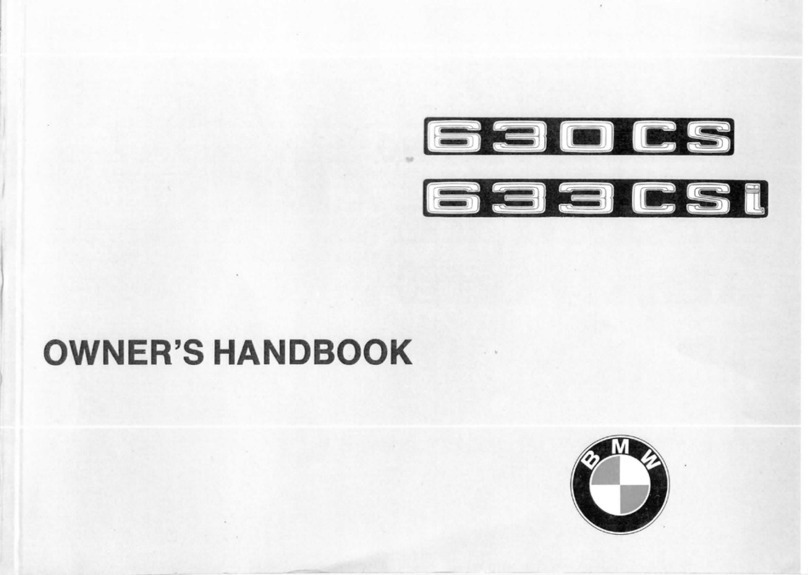
BMW
BMW 630CS User guide

BMW
BMW SERIE 3 CONVERTIBLE 2002 User manual

BMW
BMW 116i 2011 User guide

BMW
BMW SERIE 5 SPORT WAGON 2005 User manual

BMW
BMW X1 - PRODUCT CATALOGUE User manual
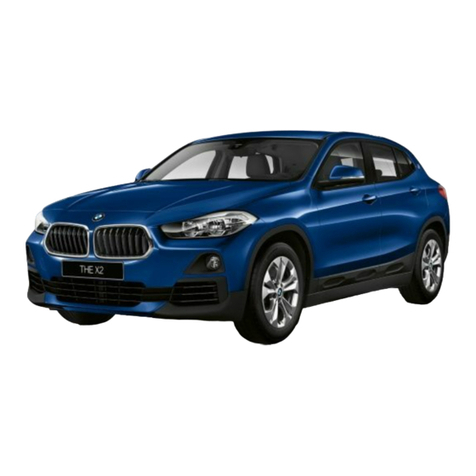
BMW
BMW X2 2022 User manual

BMW
BMW 535I User manual
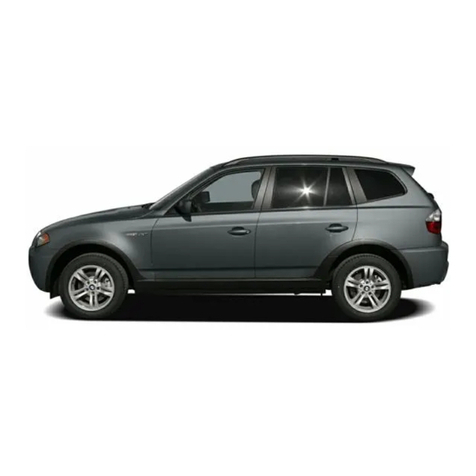
BMW
BMW 2006 X3 User manual

BMW
BMW Z4 User manual
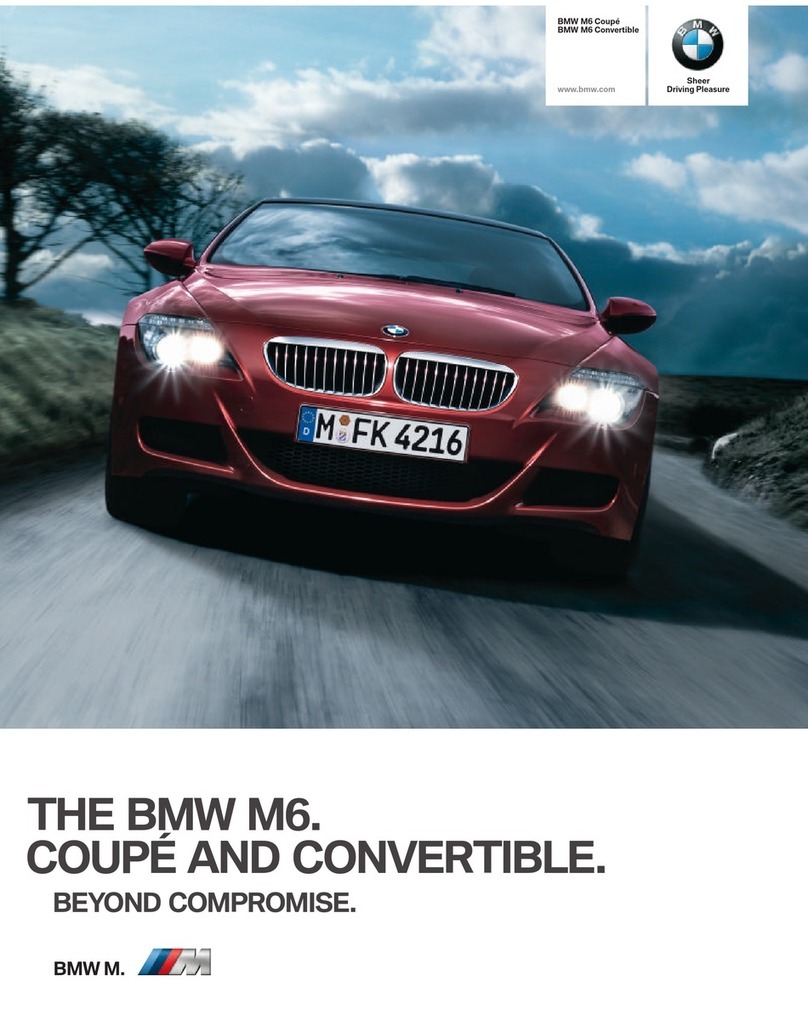
BMW
BMW M6 - User manual

BMW
BMW 5 Gran Turismo 2015 Series User manual

BMW
BMW X3 2005 User manual
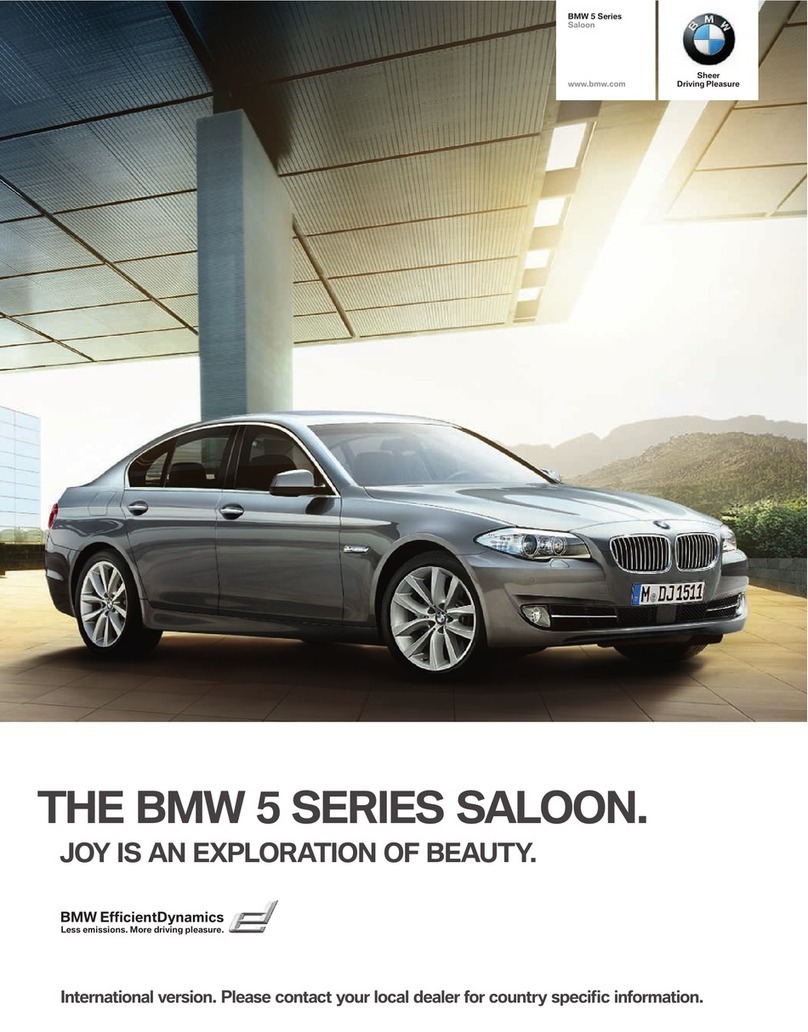
BMW
BMW 520D - BROCHURE 2010 User manual

BMW
BMW 2010 M6 User manual
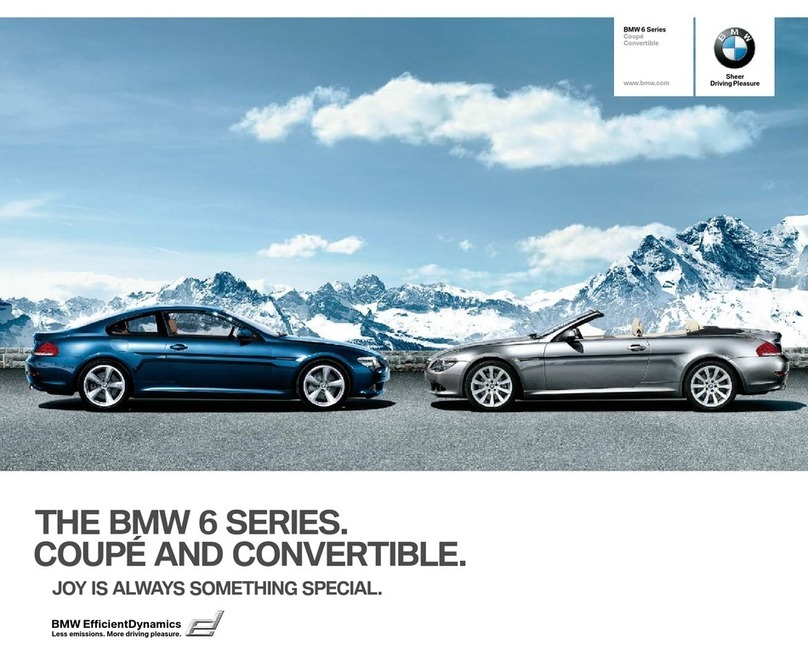
BMW
BMW 630 BROCHURE 2010 User manual

BMW
BMW 535I User manual

BMW
BMW SERIE 3 COUPE 2001 User manual

BMW
BMW X3 2013 User manual
